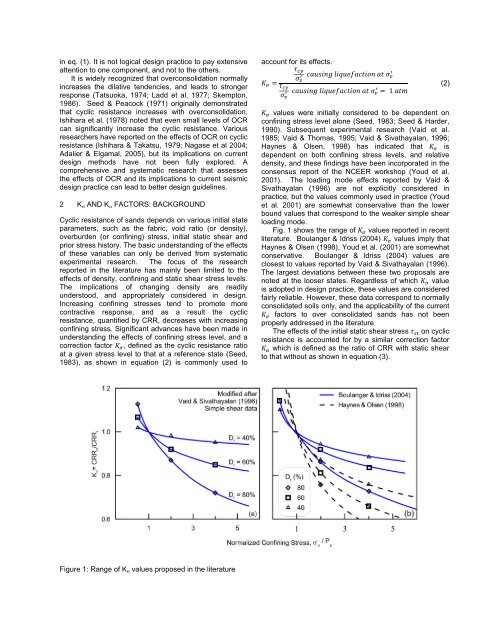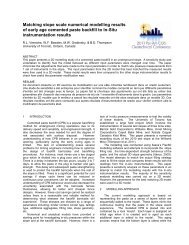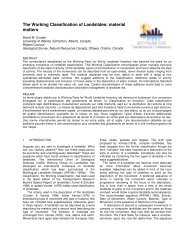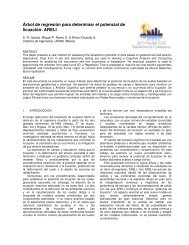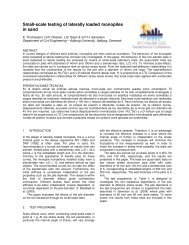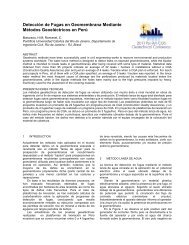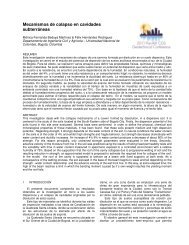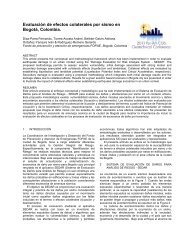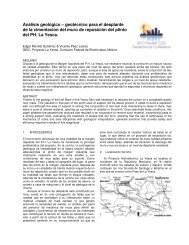MS Word Technical Paper Template
MS Word Technical Paper Template
MS Word Technical Paper Template
You also want an ePaper? Increase the reach of your titles
YUMPU automatically turns print PDFs into web optimized ePapers that Google loves.
in eq. (1). It is not logical design practice to pay extensive<br />
attention to one component, and not to the others.<br />
It is widely recognized that overconsolidation normally<br />
increases the dilative tendencies, and leads to stronger<br />
response (Tatsuoka, 1974; Ladd et al, 1977; Skempton,<br />
1986). Seed & Peacock (1971) originally demonstrated<br />
that cyclic resistance increases with overconsolidation.<br />
Ishihara et al. (1978) noted that even small levels of OCR<br />
can significantly increase the cyclic resistance. Various<br />
researchers have reported on the effects of OCR on cyclic<br />
resistance (Ishihara & Takatsu, 1979; Nagase et al 2004;<br />
Adalier & Elgamal, 2005), but its implications on current<br />
design methods have not been fully explored. A<br />
comprehensive and systematic research that assesses<br />
the effects of OCR and its implications to current seismic<br />
design practice can lead to better design guidelines.<br />
2 K σ AND K α FACTORS: BACKGROUND<br />
Cyclic resistance of sands depends on various initial state<br />
parameters, such as the fabric, void ratio (or density),<br />
overburden (or confining) stress, initial static shear and<br />
prior stress history. The basic understanding of the effects<br />
of these variables can only be derived from systematic<br />
experimental research. The focus of the research<br />
reported in the literature has mainly been limited to the<br />
effects of density, confining and static shear stress levels.<br />
The implications of changing density are readily<br />
understood, and appropriately considered in design.<br />
Increasing confining stresses tend to promote more<br />
contractive response, and as a result the cyclic<br />
resistance, quantified by CRR, decreases with increasing<br />
confining stress. Significant advances have been made in<br />
understanding the effects of confining stress level, and a<br />
correction factor K σ , defined as the cyclic resistance ratio<br />
at a given stress level to that at a reference state (Seed,<br />
1983), as shown in equation (2) is commonly used to<br />
account for its effects.<br />
τ cy<br />
′<br />
σ′ causing liquefaction at σ v<br />
K σ = v<br />
τ cy<br />
σ′ causing liquefaction at σ ′ v = 1 atm<br />
v<br />
K σ values were initially considered to be dependent on<br />
confining stress level alone (Seed, 1983; Seed & Harder,<br />
1990). Subsequent experimental research (Vaid et al.<br />
1985; Vaid & Thomas, 1995; Vaid & Sivathayalan, 1996;<br />
Haynes & Olsen, 1998) has indicated that K σ is<br />
dependent on both confining stress levels, and relative<br />
density, and these findings have been incorporated in the<br />
consensus report of the NCEER workshop (Youd et al.<br />
2001). The loading mode effects reported by Vaid &<br />
Sivathayalan (1996) are not explicitly considered in<br />
practice, but the values commonly used in practice (Youd<br />
et al. 2001) are somewhat conservative than the lower<br />
bound values that correspond to the weaker simple shear<br />
loading mode.<br />
Fig. 1 shows the range of K σ values reported in recent<br />
literature. Boulanger & Idriss (2004) K σ values imply that<br />
Haynes & Olsen (1998), Youd et al. (2001) are somewhat<br />
conservative. Boulanger & Idriss (2004) values are<br />
closest to values reported by Vaid & Sivathayalan (1996).<br />
The largest deviations between these two proposals are<br />
noted at the looser states. Regardless of which K σ value<br />
is adopted in design practice, these values are considered<br />
fairly reliable. However, these data correspond to normally<br />
consolidated soils only, and the applicability of the current<br />
K σ factors to over consolidated sands has not been<br />
properly addressed in the literature<br />
The effects of the initial static shear stress τ st on cyclic<br />
resistance is accounted for by a similar correction factor<br />
K α which is defined as the ratio of CRR with static shear<br />
to that without as shown in equation (3).<br />
(2)<br />
Figure 1: Range of K σ values proposed in the literature


